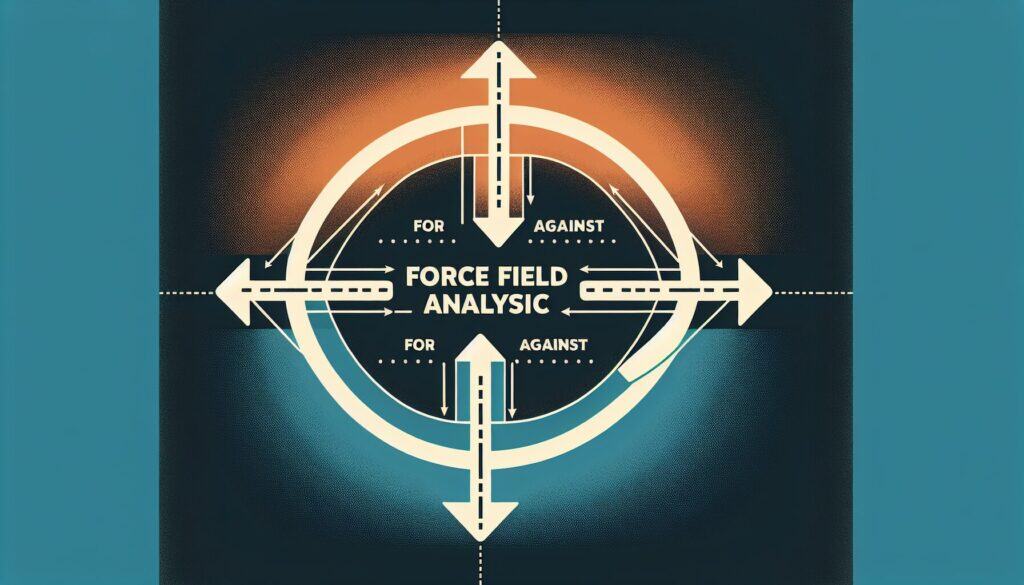Analyse der Kräfte, die für und gegen eine vorgeschlagene Änderung sprechen.
- Methodologien: Wirtschaft, Lean Sigma, Herstellung, Problemlösung, Qualität
Kraftfeld-Analyse

Kraftfeld-Analyse
- Änderungsmanagement, Kontinuierliche Verbesserung, Prozessverbesserung, Projektmanagement, Qualitätsmanagement, Risikomanagement, SWOT-Analyse, Teamarbeit
Zielsetzung:
Wie es verwendet wird:
- Ein Instrument zur Entscheidungsfindung, bei dem die treibenden Kräfte (Faktoren, die die Veränderung unterstützen) und die hemmenden Kräfte (Faktoren, die der Veränderung entgegenstehen) ermittelt werden. Jeder Kraft wird in der Regel eine Punktzahl zugewiesen, und die Analyse hilft bei der Entwicklung einer Strategie zur Stärkung der treibenden Kräfte und zur Schwächung der hemmenden Kräfte.
Vorteile
- Bietet eine klare visuelle Zusammenfassung der Faktoren, die eine Veränderung beeinflussen; hilft, die Komplexität einer Veränderungsinitiative zu verstehen; erleichtert die Diskussion und Konsensbildung; hilft bei der Entwicklung von Strategien zur effektiven Bewältigung von Veränderungen.
Nachteile
- Kann bei der Identifizierung und Bewertung von Kräften subjektiv sein; Kann komplexe Situationen zu sehr vereinfachen; Liefert keine endgültige Lösung, sondern nur einen Rahmen für die Analyse; Der Prozess der Quantifizierung qualitativer Kräfte kann eine Herausforderung sein.
Kategorien:
- Personalwesen, Problemlösung, Projektmanagement
Am besten geeignet für:
- Entscheidungen über eine vorgeschlagene Veränderung treffen, indem systematisch die Faktoren ermittelt und bewertet werden, die diese Veränderung unterstützen oder behindern.
Force Field Analysis is widely applied across various sectors such as healthcare, education, manufacturing, and software development during the planning and implementation phases of projects that involve change initiatives. This methodology is typically initiated by project managers, change agents, or team leaders who seek to drive significant modifications, like the introduction of new technologies or reforms in organizational policies. It is valuable during the early stages of projects when understanding stakeholder perceptions is essential for success or when conducting impact assessments related to potential changes. Participants in these discussions often include cross-functional teams comprising engineers, designers, business analysts, and end-users, ensuring diverse perspectives are represented. By quantifying driving and restraining forces, teams can visualize the balance of power influencing the change process, which aids in facilitating open dialogue for consensus-building. For example, in an engineering context, Force Field Analysis may be employed during the design phase of a new product to weigh the benefits of cutting-edge materials against potential production challenges, enabling more informed decision-making. Furthermore, it supports strategic planning by allowing organizations to formulate actionable steps to bolster supportive factors while mitigating resistance, thus increasing the likelihood of successful implementation within a structured Änderungsmanagement framework.
Die wichtigsten Schritte dieser Methodik
- Clearly define the change initiative or decision to be analyzed.
- Identify and list all driving forces supporting the change.
- Identify and list all restraining forces opposing the change.
- Assign scores to each driving and restraining force according to their impact.
- Create a visual representation of the driving and restraining forces.
- Analyze the balance of forces to understand potential outcomes.
- Develop strategies to strengthen driving forces and mitigate restraining forces.
- Implement the strategies and monitor the effects on driving and restraining forces.
Profi-Tipps
- Incorporate stakeholder feedback throughout the Force Field Analysis process to refine the understanding of driving and restraining forces.
- Use a scoring system that quantifies the strength of each force, enabling data-driven discussions about prioritization and strategy development.
- Regularly revisit and update the Force Field Analysis to adapt to changing internal and external factors that may influence the change initiative.
Verschiedene Methoden lesen und vergleichen, Wir empfehlen die
> Umfassendes Methoden-Repository <
zusammen mit den über 400 anderen Methoden.
Ihre Kommentare zu dieser Methodik oder zusätzliche Informationen sind willkommen auf der Kommentarbereich unten ↓ , sowie alle ingenieursbezogenen Ideen oder Links.
Historischer Kontext
1902
1907
1915
1915-11
1918
1920
1922
1902
1904
1913
1915
1916
1919-05-29
1920
1924
(wenn das Datum nicht bekannt oder nicht relevant ist, z. B. "Strömungsmechanik", wird eine gerundete Schätzung des bemerkenswerten Erscheinens angegeben)















Verwandte Artikel
Master Production Schedule (MPS)
Massenanpassung
Marketing-Trichter
Marketing-Audit
MAPO-Index (Bewegung und Unterstützung von Krankenhauspatienten)
Fertigungsressourcenplanung (MRP II)